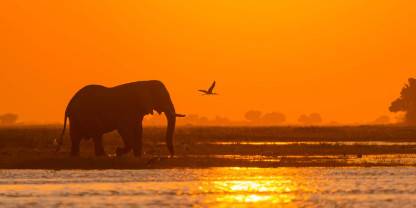Average Expert Rating
Rating Breakdown
Write a User ReviewCrowds of Elephants and Zebras, a Short Hop From Victoria Falls
Chobe is fantastic for elephants. Estimates of the size of the population vary – some hedge their bets by saying it’s over 50,000, while others suggest it’s over 120,000. I’ve often seen huge herds, up to 400 strong, in the mopane woodlands and lush swamps beside the Linyanti River and Chobe River, which marks the park’s northern boundary. Inevitably, there’s also much evidence of their destructiveness in well-trampled pathways and mangled trees. Lions are also plentiful, particularly near the waterholes, some of which have pumps to keep them replenished.
Thanks to unusually high rainfall in recent years, the region around the Savuti Channel in the west has become a superb place to see birds, buffalo,
Read more
leopards and streams of zebras. The marshlands of the Linyanti region in the northwest are even soggier; after the summer rains, rare antelopes such as red lechwe and sitatunga can be seen here.Chobe: Elephant Kingdoms
Not surprisingly, Chobe Riverfront can get very busy, so the more I visit, the more I find myself hurrying past to the other, more remote areas of the park. The Linyanti Marshes are more isolated, and one of the last redoubts of the African wild dog; elephant, lion, leopard and buffalo are all possible. In recent years, the roads into Linyanti (not to be confused with the nearby Linyanti Concession) have been hard work, with deep sand
Read more
a problem.But above all, I love Savuti (sometimes spelled Savute). Every time I’ve been it has offered something different. Savuti boasts a stunning combination of open plains, riverine woodland and large rock monoliths that are known leopard haunts. Gobabis Hill, one such monolith, has San rock paintings and an ancient baobab; here I spent a morning alone with a pride of seven lions before the other vehicles arrived. On my second-to-last visit to the Savuti Marshes, I got up close and personal with a pride of 16 lions. And most recently, I stayed in a wonderful mobile camp run by &Beyond with lions roaring nearby, and then spent a precious morning watching the comings and goings of an African wild dog den.
Spectacular Landscapes, Wonderful Wildlife Sightings and the ‘Gnarliest’ Elephants in Africa
We had been almost a month on a self-drive safari in Botswana and had had stunning wildlife sightings. The country had – once again – surpassed all expectations but we had one last aim. To see wild dogs would be the icing on the cake and we hoped that Chobe would deliver. Chobe is certainly one of the best elephant territories you will ever find – in fact the area suffers fairly heavily from vegetation damage caused by the great herds. Perhaps because of dense population the elephants can be more aggressive than elsewhere. The two Defenders in our convoy were seriously charged on two occasions (nerve-wracking but painless and without damage) and had half a dozen mock-attacks. In our last hour in the park we were following guide Bart Vanderpitte in the lead vehicle when suddenly he started shouting over the radio: “Dogs! Dogs! Dogs!” We watched a pack of about 8 wild dogs close in and kill an impala buck. Take my word for it: Chobe delivers!
Elephants and Even More Elephants!
Elephantophiles take note. If you want to get up close and personal with the lumbering giants of the African veld, then there is no better place on Earth than Chobe National Park. With an estimated 120,000 elephants roaming its bounds – which is the highest concentration of elephants on the African continent – even on the briefest of game drives you’ll be guaranteed several sightings. One herd we spied stretched further than the eye could see. But there’s much more to Chobe than elephant. The third largest reserve in Botswana, it’s also home to lion, leopard, hippo, buffalo, wild dog, hyena and antelope. If you have the time, be sure to take a sunset cruise on the Chobe River. The stretch of river between Kasane and the Serondela campsite literally heaves with wildlife. And, of course, there’s no better way to end your safari than with an icy G&T in your hand watching the masses of hippos, elephants and crocodiles as the sun slowly sinks below the horizon. Pure bliss!
Green Plains Covered With Wildlife
After the Serengeti, Chobe is perhaps the best place in Africa for seeing wildlife in an open savanna setting. It also has an incredible number of elephants – estimates range between 70,000 and 120,000, making it home to one of Africa’s most concentrated populations. I certainly had some of my most memorable elephant sightings here, from up-close encounters to views of herds kicking up dust on the plains. The Chobe Riverfront has the highest concentration
Read more
of animals; there seemed to be a lion or leopard dozing under every other bush. However, its accessibility and proximity to Kasane mean it gets busy, so it’s worth exploring quieter, 4WD-only areas of the park.Land of the Giants
But the biggest attraction here is undoubtedly the unparalleled elephant population. I’ve witnessed single herds at least 200 strong and these beautiful giants can often be seen swimming across the river. A sunset boat cruise is a special way to enjoy Chobe’s elephants and its natural beauty, but for great pics and less boat traffic I prefer to be out on the river in the morning. I’ve also had the pleasure of staying a couple of nights on a houseboat on the river; it was a special treat watching great herds of game come to drink as I ate a delectable brunch on board.
Game

